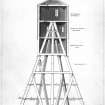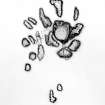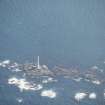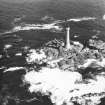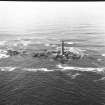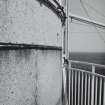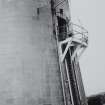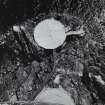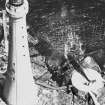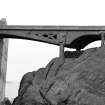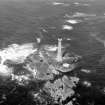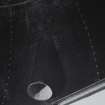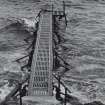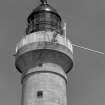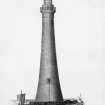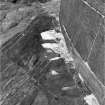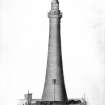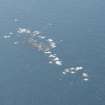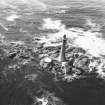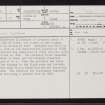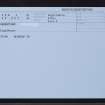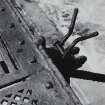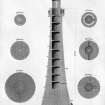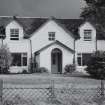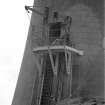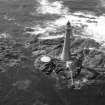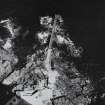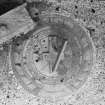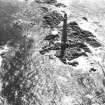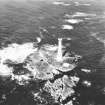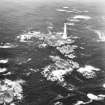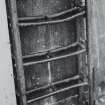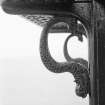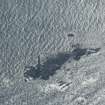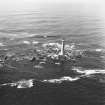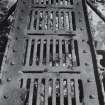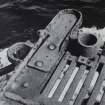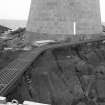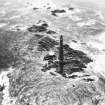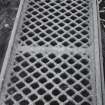Following the launch of trove.scot in February 2025 we are now planning the retiral of some of our webservices. Canmore will be switched off on 24th June 2025. Information about the closure can be found on the HES website: Retiral of HES web services | Historic Environment Scotland
Tiree, Skerryvore Lighthouse
Lighthouse (19th Century)
Site Name Tiree, Skerryvore Lighthouse
Classification Lighthouse (19th Century)
Alternative Name(s) Skerry Vore Light
Canmore ID 21407
Site Number NL82NW 1
NGR NL 84004 26289
Datum OSGB36 - NGR
Permalink http://canmore.org.uk/site/21407
- Council Argyll And Bute
- Parish Tiree
- Former Region Strathclyde
- Former District Argyll And Bute
- Former County Argyll
NL82NW 1 8384 2629
N56 19.4 W7 6.9
Formerly entered at cited locations NL c. 840 263 and NL c. 840 263.
For (associated) Hynish, signal station or lighthouse establishment (NL 9853 3918) and harbour (NL 986 392), see NL93NE 8 and NL93NE 9 respectively.
For bell founded in 1843 for Skerryvore lighthouse and now held in St Cona's Church, Loch Awe (NN 1158 2673), see NN12NW 21.
For associated quarries at Camas Tuath, Mull (NM 3520 2424), see NM32SE 16.
EXTERNAL REFERENCE
Source: Mr R Q C Stevenson, 18 Mortonhall Road, Edinburgh 9.
29. missing
30. The Skerryvore Lighthouse. Printed Sheet.
31. Skerryvore Lighthouse. Notice to mariners. Notice of erection.
37. Skerryvore Lighthouse. Design for a cast-iron columnal Lighthouse proposed to be erected on the Skerryvore rocks by Com. Samuel Brown (1776-1852). Sgd. Sam Brown, Netherbyres House, Berwickshire 1 Jany 1836. Watercolour. Longitudinal Section. Scale 5" - 30 ft. Note: The Letters refer the the printed Report.
33. Skerryvore Rock. Elevation of a bronze Lighthouse proposed to be erected on the Skerryvore Rocks by Samuel Brown (1776-1852). Granite column with internal accomodation. Pen and watercolour. Scale 5" - 20ft. Signed by George Rennie London 7 July 1836.
34. Skerryvore Lighthouse (Office Copy). Section showing use of compartments ( floors). Pen and grey and pink wash. Scale 1/10" - 1ft.
Lighthouse upon the Skerryvore Rock. Dated Edinburgh 23 December 1843. Verso: Specification of the position of the Lighthouse and the appearance of the Light by Mr Alan Stevenson (1807-65). Text and chart of position of Lighthouse.
38. Elevation of a lighthouse ( plate V1). James Andrews delt. pen and watercolour. Scale 1/4" - 1ft. in bottom right hand corner "Stevenson's account of Skerryvore Lighthouse" ( Alan Stevenson 1848). pen and watercolour. Scale 1/4" - 1ft..
39. Section of a lighthouse (Plate V11). Course (floor) plans and sections showing dates for finishing parts of the building. (Alan Stevenson's Account of the Skerryvore Lighthouse, 1848)
40a. Curves for lighthouse tower and illustration of a Marine Dynamomenter (Plate IV). Engraved. W & A K Johnston Scuplt. ( Alan Stevenson's Account of the Skerryvore Lighthouse, 1848)
(Undated) information in NMRS.
(Location cited as NL 83 27). Skerryvore Lighthouse, built 1838-44 by engineer Alan Stevenson. A circular-section, ten-storey masonry tower, 138 ft (42.03m) high on the largest exposed rock of an extensive reef. The interior was badly damaged by fire in 1954, and has been repaired and re-equipped, but the lantern framework is original.
J R Hume 1977.
This rock lighthouse suffered minor bomb damage in 1940 and extensive damage (some of it structural) in the fire of 1954, which destroyed the optical system. After reconstruction, the tower was electrified (in 1959) and fitted with a Racon beacon (after 1968).
R W Munro 1979.
NL 840 263. Skerryvore Lighthouse is situated about 11 nautical miles WSW of Tiree, and stands on the largest exposed rock of an extensive reef. Designed and built by Alan Stevenson, work on its construction started in 1838; the masonry structure was completed in 1842, and the light was first exhibited in 1844. The circular tower measures 12.8m in diameter at base, and the masonry structure rises to a height of 42m. From the entrance the tower rises through ten storeys to the light-room and lantern, each of the lower nine floors being vaulted and measuring 3.7 m in diameter. The interior was thoroughly repaired and re-equipped following a serious fire in 1954.
Visible on RCAHMS air photographs AG 9053-60 (flown 1978).
RCAHMS 1980, visited 1974.
(Location cited as N56 19.4 W7 6.9 [NL 8384 2629]).
Admiralty List of Lights 1980.
Name: Skerryvore (1838-44)
Location: N56 19 W7 7 Atlantic, 12 miles SW end of Tiree
Designed: Alan Stevenson
Built: Alan, and later Thomas, Stevenson
Light first exhibited: 1 February 1844
Description: circular granite tower
Height of light above MHW: 151ft (46m)
Height of tower: 138ft (42m)
Light source and characteristics: W Fl (1) ev 10 secs. 250W metal halide lamp: 1,000,000 cp: 26nm nominal range
Fog warning apparatus: Horn (1) ev 60 secs
Manning: unwatched (automatic since 31 March 1994), monitored from Northern Lighthouse Board HQ, Edinburgh
Considered to be Scotland's most graceful tower, and Alan Stevenson's greatest work. The lengthy automation process involved removing blue asbestos
C Nicholson 1995.
Modification (1956 - 1959)
Reconstruction work following fire of 1954.
R W Munro 1979
Field Visit (1974)
NL 840 263. Skerryvore Lighthouse is situated about 11 nautical miles WSW of Tiree, and stands on the largest exposed rock of an extensive reef. Designed and built by Alan Stevenson, work on its construction started in 1838; the masonry structure was completed in 1842, and the light was first exhibited in 1844. The circular tower measures 12.8m in diameter at base, and the masonry structure rises to a height of 42m. From the entrance the tower rises through ten storeys to the light-room and lantern, each of the lower nine floors being vaulted and measuring 3.7 m in diameter. The interior was thoroughly repaired and re-equipped following a serious fire in 1954.
Visible on RCAHMS air photographs AG 9053-60 (flown 1978).
RCAHMS 1980, visited 1974.
Publication Account (1985)
Few visitors will see the magnificent lighthouse of Skerryvore except remotely through binoculars, but the achievement of its construction on a remote windand sea-swept reef has an important place in lighthouse history. When Sir Waiter Scott visited the reefin 1814 in the company of Robert Stevenson, he described a 'long ridge of rocks (chiefly under water), on which the tide breaks in a most tremendous style'. 'Our rowers, however, get the boat into a quiet creek between two rocks where we contrive to land well wetted.' Such were the problems of the situation that it was not until 1834 and 1835 that the survey of the reef was undertaken. The hardships of the various seasons of work on the rock with the wind whistling and the waves foaming round are a constant feature of Stevenson's account of the building. The foundation pit for such a massive tower took twenty men over two hundred days! The tower is 42m in height rising in a gentle curve from a basal diameter of 12.8m, and first showed its light on 1 February 1844.
If the lighthouse itself remains a distant pencil on the horizon, the shore establishment and harbour, from which workmen and stone were shipped out to the reef can still be seen. Here each stone was carefully prepared and shaped for its special position within the structure. It had been entended to use local stone, a hard gneiss, but this proved difficult to work and, although the bottom three courses of the tower are of Hynish stone, the remainder are of Ross of Mull granite.
The well-built pier, dock, storehouses and shorebarracks for the masons and seamen still survive, as well as a signal-tower and a row of lightkeepers' houses. The signal-tower has been refurbished as a museum, with details of the building of Skerryvore and of the method of communication by semaphore signals, seen through telescopes, between the tower at Hynish and the lighthouse.
An unexpected problem at Hynish harbour was that it was liable to silting, and Stevenson devised an ingenious method of scouring out the dock. Up to a million gallons of water could be collected in a reservoir above the site, which could be let out through a conduit in a controlled flood to clear the harbour basin and channel of accumulated sand.
Information from ‘Exploring Scotland’s Heritage: Argyll and the Western Isles’, (1985).
Publication Account (2007)
The creation of Skerryvore Lighthouse, on an occasionally 5-ton rock swept reef, exposed to the full fetch of the Atlantic 12 miles west-south-west of Tiree, was an extraordinary human achievement. Sadly, it took its toll on the health of its designer/resident engineer, Alan Stevenson, who also designed and directed the building of the Hynish shore station at Tiree with its pier, dock, stores, houses, reservoir and signal station.
The masonry tower supporting the lantern is 13812 ft high with a diameter of 42 ft at the base, tapering to 16 ft at the top. It houses a flashing white light 150 ft above high water with a nominal range of 26 miles. Unlike the Bell Rock Lighthouse (2-10) its base is above high water level and its lower masonry courses were not dovetailed, resulting in a considerable cost saving in stone working. Apart from the first three courses, which were of Hynish gneiss which proved difficult to work, the lighthouse is built of granite from the Ross of Mull brought to Hynish shore station for dressing before shipment to the rock.The Hynish facilities included a dry dock 20 ft wide by 16 ft deep, the double entrance gate of which consisted of timber booms about 21 ft long which were lifted into position by the crane when required (see Paxton and Shipway, 2007, Highlands and Islands, 6-7).
The method of conducting the work was basically similar to that used by his father at the Bell Rock Lighthouse, by first erecting a temporary barrack beacon on the reef from which to carry out the work. Construction of the beacon started in 1838, but it was destroyed by the sea before completion. A fresh start was made in 1839, the barrack was successfully erected, and the tower was built from 1840–43. The light was first exhibited on 1 February 1844. The cost was nearly £87 000. This structure represented a landmark in scientific lighthouse design for mass combined with elegance of outline. Stevenson calculated the centre of gravity for towers offive different curvatures, finding that of the rectangular hyperbola to be the best, resulting in a solid tower of 62 915 cu. ft with its centre of gravity 41.227 ft from the base. He took issue with Smeaton’s analogy of an oak tree in lighthouse design, considering the action of the materials and forces to be quite different. But he acknowledged that, in general terms, Smeaton had implemented the correct design concept, which was for a tower with sides curved as ‘a solid generated by the revolution’ of the form of curve ‘about its asymptote as a vertical axis’, which had the lowest centre of gravity. The lighthouse’s exemplary design was the model for Alguada Reef Lighthouse, Burma, erected from 1862–65.
The revolving dioptric light apparatus (operating by refraction through lenses instead of reflection from mirrors), was the most advanced in the world in 1844. Stevenson’s innovation of prismatic rings below the Fresnel central lens belt further extended the dioptric effect. The prisms were made by M. Soliel at Paris under the direction of M. Le´onor Fresnel. The light source was an intricate and finely executed oil lamp with four concentric wicks, now preserved at the Northern Lighthouse Board headquarters at 84 George St, in Edinburgh.
The lighthouse was severely damaged internally by fire in 1954 and refurbished in the following year.
Paxton and Shipway 2007.
Reproduced from 'Civil Engineering heritage: Scotland - Highlands and Islands' with kind permission from Thomas Telford Publishers.















































